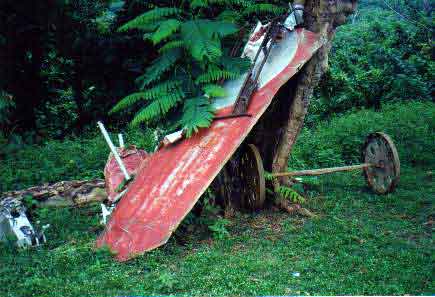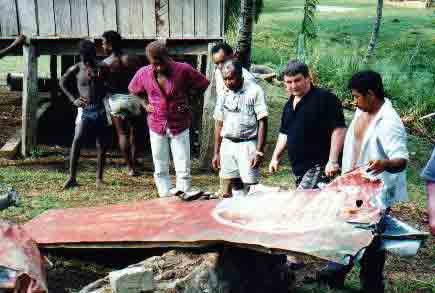|
|
|
| Missing In Action (MIA) | Prisoners Of War (POW) | Unexploded Ordnance (UXO) |
| Chronology | Locations | Aircraft | Ships | Submit Info | How You Can Help | Donate |
|
  USMC 1942   Peter Flahavin 1996   Peter Flahavin 1996  Stan Gajda 1998 |
Location The Gifu is an oval area between Hill 31 to the north and Hill 27 to the south inland from the north coast of Guadalcanal. To the east is Mount Austen. The area was dubbed "The Gifu" or "Gifu strong point" as many of the Japanese Army defenders were from Gifu in Japan. Also known as simply "Gifu". To the northwest is Hill 42. To the west are Seahorse and Galloping Horse. To the east is Mount Austen and roughly nine miles away is Henderson Field. Prewar and during the Pacific War part of the British Solomon Islands Protectorate (BSIP). During the 1960s, Barana (Mbarana) was established on the western edge of "The Gifu" between Hill 31 and Hill 27. Today located in Guadalcanal Province in the Solomon Islands. Wartime History The Gifu was a Japanese Army defensive strong point in the jungle area between Hill 31 and Hill 27. This area was known as "The Gifu" the hometown of most of the Japanese defenders who resided in Gifu Prefecture in central Honshū in Japan. During late 1942, elements of the Imperial Japanese Army (IJA) 124th Infantry Regiment and 228th Infantry Regiment built strong defenses in the area including pillboxes for machine guns made of coconut trees covered with soil supported by foxhole fighting positions for rifleman. In December 1942 the U.S. Army began the Battle of Mount Austen attacking The Gifu but met strong resistance from entrenched Japanese Army soldiers and strong defenses. To support the American attack, a road was built to the area later named Wright Road. On January 2, 1943 after a heavy artillery bombardment, the 132nd Infantry Regiment, Americal Division continue their offensive against The Gifu. To the south, the 2d Battalion caught the Japanese by surprise and captures the crest of Hill 27 then dug in to defend against a number of counterattacks. Meanwhile, the 3rd Battalion and 1st Battalion establish lines along north and east sides of The Gifu, but the American line has gaps and will take days to strengthen their positions and defend against counter attacks. On January 9, 1942 the 2nd Battalion, 35th Infantry Regiment, 25th Infantry Division "Tropic Lightning" arrives at the eastern side of The Gifu to relieve the 132nd Infantry. On January 10, 1943 the U.S. Army XIV Corps begins their Guadalcanal offensive with one of the objectives clearing The Gifu to remove the Japanese from atop Mount Austen. After preparatory fire patrols advance but are unable to make any headway against strong defenses. On January 11, 1943 patrols meet heavy fire. On January 12, 1943 Americans are halted by strong points and pillboxes. On January 13, 1943 they make negligible progress. On January 14, 1943 the depleted 2nd Battalion is reinforced by Anti-Tank Company (AT Company). On January 15, 1943 the Americans use loudspeakers to request the Japanese garrison defending The Gifu surrender without response. On January 16, 1943 the 2nd Battalion commits to a double envelopment attack to eliminate the defenders. On January 17, 1943 in the morning began a 2 1/2 hour artillery bombardment the area to cover the advance of the 2nd Battalion, to jump off positions from Hill 27 to Hill 42. On January 18, 1942 with the cordon around The Gifu complete, 2nd Battalion attacked from the northwest. On January 19, 1943 the Japanese defending The Gifu show the first signs they are beginning to weaken from repeated American attacks that continue for the next two days to reduce the position. On January 22, 1943 the 2nd Battalion supported by a single M3 Stuart tank forces a 200 yard (600' / 182.8m) gap in the north of The Gifu. During the night, most of the surviving Japanese launch a final suicidal counterattack that is repelled. On January 23, 1943 the 2nd Battalion encounters only slight resistance as they finish clearing the Gifu ending all Japanese resistance atop Mount Austen. Today During the 1960s, Barana (Mbarana) was established on the western edge of what was formally "The Gifu" between Hill 31 and Hill 27. Hill 27 Site of Japanese defense, Japanese memorial to "Oka Force". Hill 31 Site of the mass grave of the last 85 Japanese defenders killed during the final breakout attempt. Hill 35 (Japanese Memorial) Main Japanese memorial dedicated in 1984 at the foothills of Mount Austen and the Gifu. U.S. Army Memorial at Gifu Star shaped memorial to "The Final Destruction of Organized Japanese Resistance". Barana Postwar village built during the 1960. Barana village relic display area. Contribute
Information Last Updated
|
Map December 18-27 1942 Map January 8-11, 1943 Photo Archive |
| Discussion Forum | Daily Updates | Reviews | Museums | Interviews & Oral Histories |
|